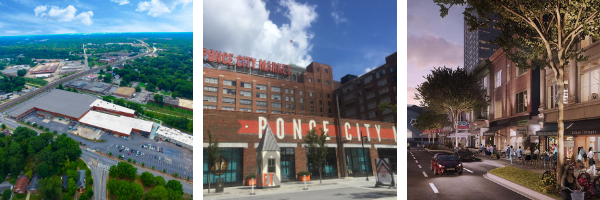Developers say they are committed to incorporating affordable options and community-focused services to offset potential gentrification.
Adaptive reuse projects are booming across metro Atlanta.
The projects range from repurposing old warehouse properties into mixed-use developments to converting factory buildings into loft-office space and restoring small retail spaces housed in historic buildings, among other examples.
Although adaptive reuse development was largely concentrated in intown Atlanta when the trend took off in the 1990s – with King Plow Arts Center in West Midtown one of the prominent examples – it is now increasingly common in the suburbs as well.
In a recent Bisnow adaptive reuse event, representatives of several Atlanta commercial real estate companies discussed notable adaptive reuse projects – both completed and under development – and the challenges of bringing these projects to fruition.
Developers are increasingly being called upon to address gentrification. Projects can face opposition over concerns that they will price out residents and businesses who were part of neighborhoods before developers arrived on the scene.
No stranger to those concerns are developers such as Jamestown, credited with energizing the adaptive reuse movement in Atlanta with its hugely successful Ponce City Market redevelopment and Newport RE, whose Hotel Row project is part of its larger vision of revitalizing the once-bustling commercial districts on Mitchell and Broad Streets in South Downtown.
“About 20 percent of the square footage we purchased was occupied, probably half of those to tenants that no one in the neighborhood wanted,” said April Stammel, Senior Vice President at Newport. “I think it’s about telling the right story and letting people know what the real impact is.”
The story Newport is emphasizing to the community is how their development will revitalize a historic but long-neglected part of the city’s urban core.
“This story is about the opportunity. We’re turning the lights back on. We’re bringing life back to these buildings,” she said.
Creating Affordability
Michael Phillips, President of Jamestown, said his company is committed to integrating community-focused features into its projects such as workforce housing and more affordable business rates.
“You can’t whitewash the fact that we’re changing the demographics of neighborhoods,” Phillips said. “We all have to be committed to creating opportunities and economic benefits for everyone. We’re just starting… but we all have to find our ways to do it.”
Tapping into local, state and federal incentives can provide funding that developers can use to pass along savings to prospective residents and businesses. Newport received $8 million in Tax Allocation District (TAD) funding for their South Downtown project.
“What that’s going to give us the ability to do is offer affordability in both the residential and commercial components,” said April Stammel. “When you think about what that means in the diversity of tenancy, not only diversity of residents, it’s incredible. We can now offer certain spaces for tenants like arts groups who can’t pay market rent or new restauranteurs who can’t afford market rent.”
Arun Nijhawan, Managing Principal of Lucror Resources – which renovated and repositioned Downtown Atlanta’s famous Flatiron Building – said there are also plenty of examples of projects receiving community support. Such was the case with the company’s $80-million Waldo’s Old Fourth Ward, a mixed-use development featuring a hotel, office space, retail and townhomes.
“To the surprise of our team, we got zero resistance. The question was, ‘when are you going to start?’” he said, noting that the project’s location several blocks away from the BeltLine in an area where “you had a certain amount of urban blight” contributed to the support from the community.
From the West End to Northlake
Ackerman & Co. is also active in adaptive reuse development. With partner MDH Partners, Ackerman is investing $85 million in its Lee + White project, an adaptive reuse redevelopment of the former “Warehouse Row” buildings in the historic West End neighborhood of Atlanta. Already home to popular breweries, a whiskey tasting room, a rock climbing gym, among other retailers and businesses, the partners are in the process of adding loft office space, a food hall, unique retail and a Great Lawn fronting the BeltLine.
“Our goal in continuing the redevelopment of Lee + White is to diversify this project beyond its popularity as an entertainment destination to serve the practical and daily needs of the community, as well as offer affordable business opportunities. New businesses and services coming to Lee + White include a family dental practice and Beya Salon Studios, which will open its newest flagship location at Lee + White, giving stylists and other salon professionals the opportunity to grow their businesses,” said Evan Ziegler, Senior Vice President of Investments for Ackerman.
“Lee + White’s container pop-up village will also open this year, providing small businesses high-visibility locations to sell their products at shorter-term lease commitments than traditional retail,” he added.
In addition, the project’s Great Lawn will be a gathering spot for the community, hosting a variety of events throughout the year.
Another adaptive reuse project Ackerman & Co. is involved in is Northlake, the transformation of the former mall northeast of Downtown Atlanta into a mixed-use project featuring offices, retail and restaurants. Ackerman Retail’s Kelly Wilson and Suzanne Shank are currently leading leasing efforts for the project’s restaurants and food stall spaces.
“With its 300,000 square feet of new medical office and office space, this redevelopment has attracted new offices for Emory Healthcare and CDC Credit Union that will bring 1,800-plus employees to the property,” said Suzanne. “For the restaurant spaces, we envision a mix of fast-casual restaurants, full-service eateries, chef-driven concepts, coffee shops and brewpubs. In revitalizing this property, this redevelopment is bringing new businesses and new retail and restaurant offerings that will benefit the surrounding community.”
